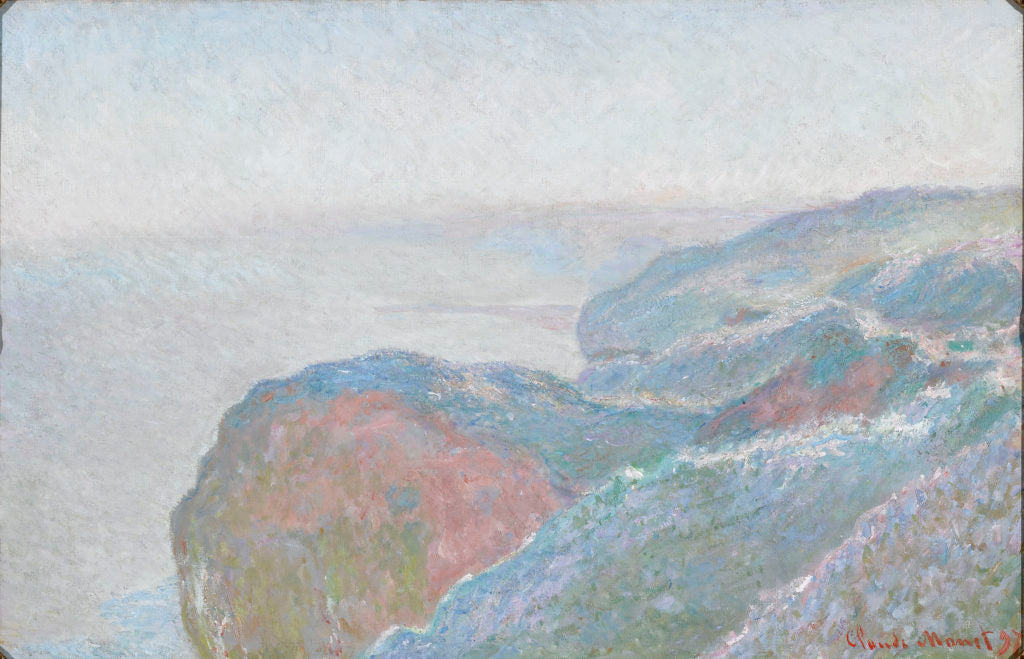"It is beautiful here [in Le Havre], my friend; every day I discover even more beautiful things. It is intoxicating me, and I want to paint it all - my head is bursting... It seems to me as if I can see nature and I can catch it all.” – Claude Monet
The Normandy coast features prominently throughout the cannon of French painting. With its chalky cliffs falling dramatically into The Channel, the area has long attracted major painters including Delacroix, Corot, Courbet, and Degas, among others. Claude Monet, with his delicate attention to light, form, and atmosphere, undoubtedly left his own mark upon the tradition. In fact, he painted the coastline throughout his career (although most relentlessly during the 1880s and again in the late 1890s). Having been raised just an hour south in Le Havre, Monet infused these compositions with his personal and sentimental ties to the region. This is illustrated well by Bord de Mer, Falaise, and Au Val Saint-Nicholas près Dieppe, a trio of stunning seascapes by Monet depicting his beloved coast of Normandy.

Bord de Mer by Claude Monet
Entitled Bord de Mer (Seaside), the serene composition depicts a quiet moment on the Normandy coast. The intimate work is completed in pastel, a rare medium for the artist, and stands as a pivotal, early work by the Impressionist master. The softened edges and careful rendering of shadow throughout Bord de Mer reveal the burgeoning artist’s fascination with ephemeral aspects of nature: the tumultuous sea, atmospheric perspective, and ever-changing light.

Monet painted this dramatic oil on canvas entitled Falaise at Pourville-sur-Mer (now part of Hautot-sur-mer). The artist was so dedicated to the practice of en plein air painting that he carried his supplies down to the beach, even in the cold of a winter’s morning, allowing him to closely observe the cliffs under various light and weather conditions. The painting, along with the artist’s larger body of landscapes, juxtaposes the ephemerality of these conditions with the permanence of the cliffs and sea. This painting was long owned by Monet’s son Michel and was later acquired by other private collectors, last making an auction appearance in 1996 at Drouot-Montaigne in Paris. It is pictured in the artist’s catalog raisonné.
Au Val Saint-Nicholas près Dieppe marks Monet’s return to Normandy over a decade later with a desire to “gain strength from the sea air.” The substantially sized canvas pays tribute to the pastel-hued early morning light as it creeps across the coast. Much like Monet’s earlier oil on canvas, the sea and sky subtly merge together at the horizon, creating a sense of expansive depth. The painting boasts a fascinating provenance, having been acquired directly from the artist by the esteemed dealer and patron Paul Durand-Ruel. It has been exhibited extensively in major museums worldwide including the Royal Academy in London, the Art Institute of Chicago, and the Museum of Fine Arts, Boston. Its provenance also boasts important private collections including that of Harris Whittemore, Pedro Vallenilla de Echevarria, and artist Kurt Stern. Additional works from this series by Monet are in the permanent collections of the Hermitage Museum, as well as The Phillips Collection in Washington, D.C.
Together, these three works attest to Monet’s love for this region of France, and perhaps even more importantly, they capture his ever-evolving approach to creating powerful works of art. While the pastel on paper, created very early in Monet’s artistic career, reveals the influence of Barbizon painters upon the artist’s technique, the later oils are wholly his own. The earlier Falaise is comprised of mostly linear, sketch-like brushstrokes of numerous colors that together create a sense of movement while the later Au Val Saint-Nicholas près Dieppe reveals the artist’s fully mature style, evoking complete serenity with its wide swathes of pastel hues, some of which are blended on canvas and others that require the eye to do so. The two oil on canvas paintings complement each other well and feature an almost whimsical aesthetic coincidence—the form of the background in the later painting closely mimics the shape of the foreground (the cliffs) from Falaise. These three works together speak volumes of Monet’s dedication to nature and his innate need to record it for posterity across the seasons and the years.







